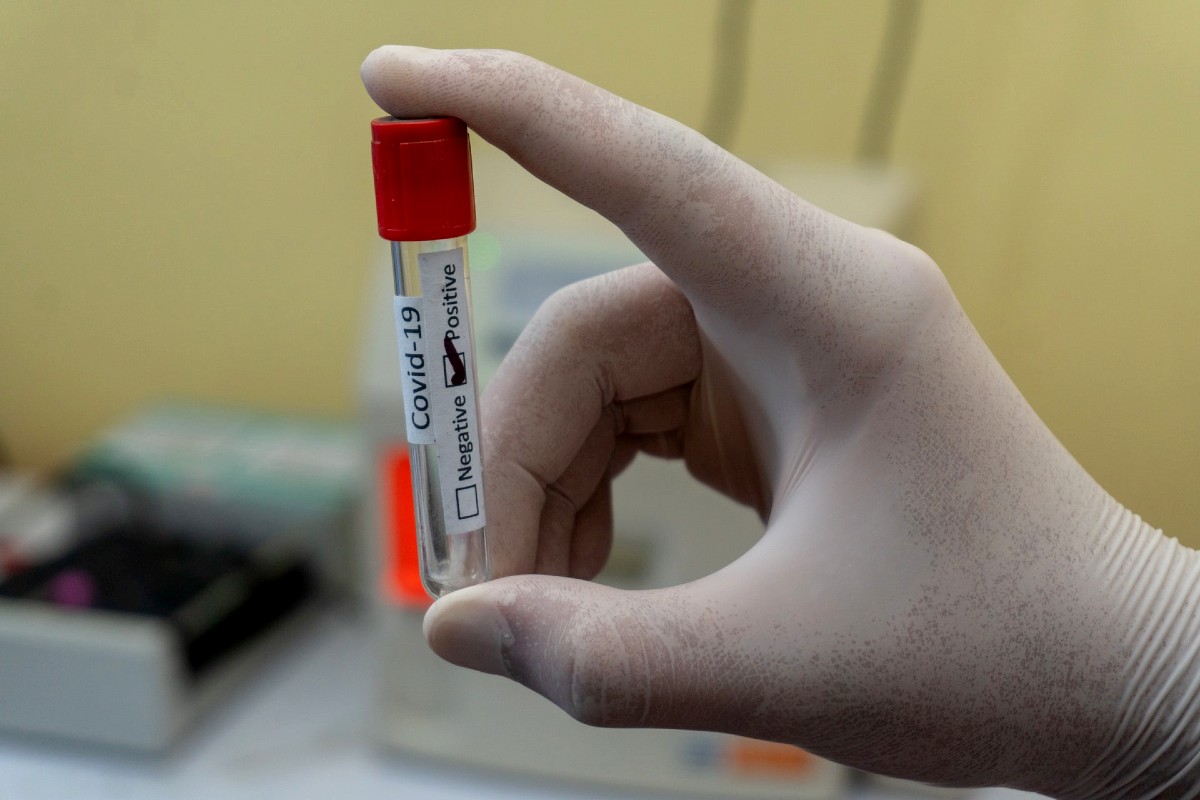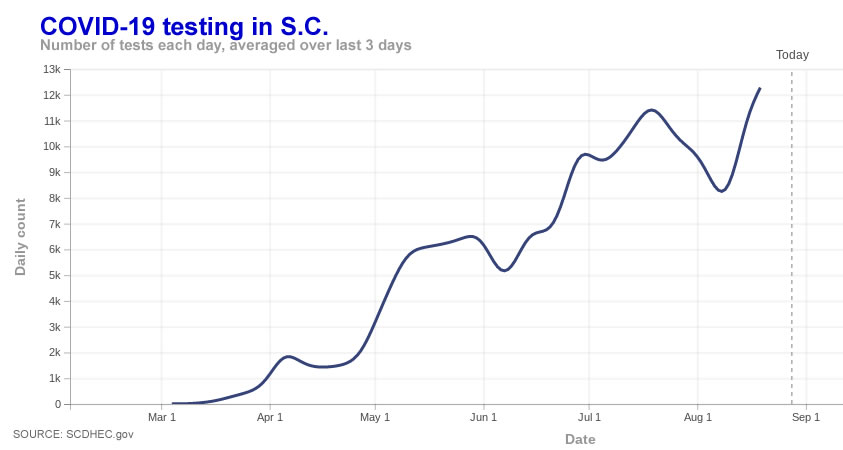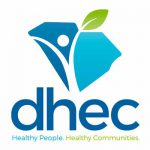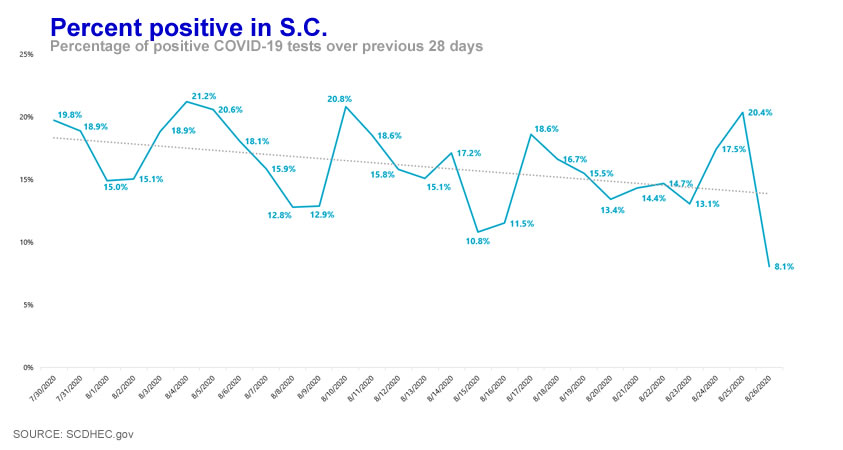
By Lindsay Street, Statehouse correspondent | State officials say coronavirus testing has declined in the last month while, at the same time, new cases have fallen under 1,000 per day.
But that doesn’t necessarily mean the state is recovering quickly from COVID-19, particularly since hospitalizations due to the virus are on the rise since Aug. 24.
One state official said the decline in new cases might be due to fewer tests being done.
“It’s possible that less cases have been identified due a recent decrease in overall testing,” according to statements by Dr. Brannon Traxler, a S.C. Department of Health and Environmental Control (DHEC) physician.
In comments this week that appear to buck federal advisories on testing, the state appears poised to expand testing to whole populations, not just those who have had contact with an infected person.
 “We need to have more people getting tested regularly in order to stop this disease,” Traxler said, describing testing as “absolutely essential.”
“We need to have more people getting tested regularly in order to stop this disease,” Traxler said, describing testing as “absolutely essential.”
“It helps us identify people who are infected with the virus,” she said. “And testing is important for identifying individuals who have the virus but are asymptomatic and are spreading the virus unknowingly.”
In statements this week, the Centers for Disease Control and Prevention Director Dr. Robert Redfield said only people confirmed to have been exposed to the coronavirus should consider testing. Earlier this week, he had released a statement that only those exhibiting symptoms after an exposure needed a test.
It is unclear when Traxler made her statements, however. On Tuesday, Statehouse Report reached out to DHEC’s media relations staff asking to learn more about testing in South Carolina. DHEC’s Laura Renwick sent the comments from Traxler about 30 minutes later, characterizing them as “recent statements.” On Friday, prior to deadline, Statehouse Report tried unsuccessfully to clarify the timing of the statements since similar comments were made to other outlets and attributed to Traxler last week and the week before.
The question of who should get tested comes amid a Senate panel advising DHEC to expand daily testing to 10 percent of the state’s population (500,000 per month day) while the state has only tested 0.1 percent of the population over a 14-day average. Some experts say that’s not enough to show a true decline in cases or to curb the virus’ deadly spread.
The decrease in testing
 In the last 14 days, DHEC has reported an overall decline in positive cases, from more than 1,000 cases reported on Aug. 14 to 424 cases reported on Aug. 27. In that time period, the average number of tests per day has been 5,022, with an average percent positive of 14.7 percent for 723 daily cases, according to a report analysis by Statehouse Report.
In the last 14 days, DHEC has reported an overall decline in positive cases, from more than 1,000 cases reported on Aug. 14 to 424 cases reported on Aug. 27. In that time period, the average number of tests per day has been 5,022, with an average percent positive of 14.7 percent for 723 daily cases, according to a report analysis by Statehouse Report.
Testing has peaked and valleyed over the time frame. On Aug. 14, DHEC reported 6,767 tests. By Aug. 18, that daily number dropped to 3,715. Daily testing rose to a 14-day high of 7,438 on Aug. 21. But the number declined, again, to 5,235 tests Thursday.
Clemson University public health expert Lior Rennert called the question of decrease in cases “complicated.”
“This completely depends on why there is less testing,” he said.
Renwick in DHEC’s media relations told Statehouse Report this week some private labs have experienced longer wait times for results, “which can be a deterrent for individuals getting tested.”
“While DHEC doesn’t have authority over private labs — they are regulated at the federal level — DHEC is working with private labs to help with supply shortages where possible,” she wrote.
Renwick said DHEC’s Public Health Laboratory is “well-stocked” and has maintained a 24- to 48-hour turnaround on test results. The current daily capacity is 2,000 tests per day, but the agency has worked with private partners to bring that capacity up to 8,800 per day, she said. The agency only accounts for one-in-five tests in the state, according to DHEC data.
More testing ahead
Starting in September, DHEC will hold at least one testing event per week in each county, Renwick said. Two or three per week will be held in large counties. Those tests will be free and available to anyone regardless of symptoms. Results will be available within 48 to 72 hours, Renwick said.
DHEC is also working with the University of South Carolina, the Medical University of South Carolina and Clemson University on quicker, less invasive saliva testing, Renwick said.
To ramp up testing to adequate levels, the agency will need to employ saliva testing, Beaufort Republican Sen. Tom Davis said.
Davis told Statehouse Report he has recently emailed DHEC to again reiterate what the Senate wants from the agency in getting to 10 percent population testing daily.
“That’s something that should be happening now. We need this now, and you (DHEC) tell us, the General Assembly, what you need to get to that goal,” Davis said, adding that testing only 2 or 5 percent of the population won’t lead to mitigation of the virus.
“If we want to see cases decline, if we want to slow community spread, we ramp up testing. Testing whole populations on a mass-scale,” he said. “We know that’s the way to slow community spread.”
Davis said testing can help get people to self-isolate and help identify more infected people for contact tracers.
Why more testing matters
 If you don’t do enough testing for the virus, then you don’t know how widespread it is in the community, experts say.
If you don’t do enough testing for the virus, then you don’t know how widespread it is in the community, experts say.
“If you report only the number of cases but you do not report the number of tests then you don’t know if the declining number of cases is a good thing,” said former USC professor and public health expert Gere Fulton of Columbia. “What we really need to know from a public health standpoint is whether or not things are getting safer for people in South Carolina.”
To understand whether the state is doing enough testing, experts point to two indicators: the percentage of positive tests and hospital-bed occupancy.
“If the percent positive is not going up with the decrease in testing then that would mean that the decrease in cases is not due to the decrease in testing,” Rennert said. “But if the percent positive is staying positive or going down then it’s a sign that cases are not going down due to the decreased testing.”
A percent positive of 5 percent is recommended by federal and international organizations, such as the World Health Organization, for virus control and considerations for reopening the economy. It’s a metric that has peaked and valleyed in South Carolina, usually hovering between 10 and 20 percent.
“We continue to look at several metrics. We would like for the percent positive to be lower than it is currently,” Traxler said.
But if cases are truly dropping, Rennert said, the state should also see fewer hospitalizations. According to DHEC data, hospital-bed occupancies for all regions appear to be on the rise over the last week.
- Have a comment? Send to: feedback@statehousereport.com
















 We Can Do Better, South Carolina!
We Can Do Better, South Carolina!
Thank you for this insightful article. Many of us have been proclaiming the inadequacy of testing as a possible reason for the decline in cases reported. If all you read are some newspaper headlines and articles, then it is easy to be lulled into believing that we’re on the right path and that Covid19 is beginning to subside. We all want this to be the case, of course, but only when that declaration is made based upon demonstrated sound scientific reasoning, not wishful thinking.
Please, continue with the probing articles that I have come to expect from the Statehouse Report.
Pingback: Charleston Currents – NEW for 8/31: Testing, Sanford’s new mission and more testing
Pingback: Charleston Currents – FOCUS, Palm: Governor should create new state health testing office
Pingback: Statehouse Report – NEW for 9/4: Energy needs; State revenues; Protecting democracy